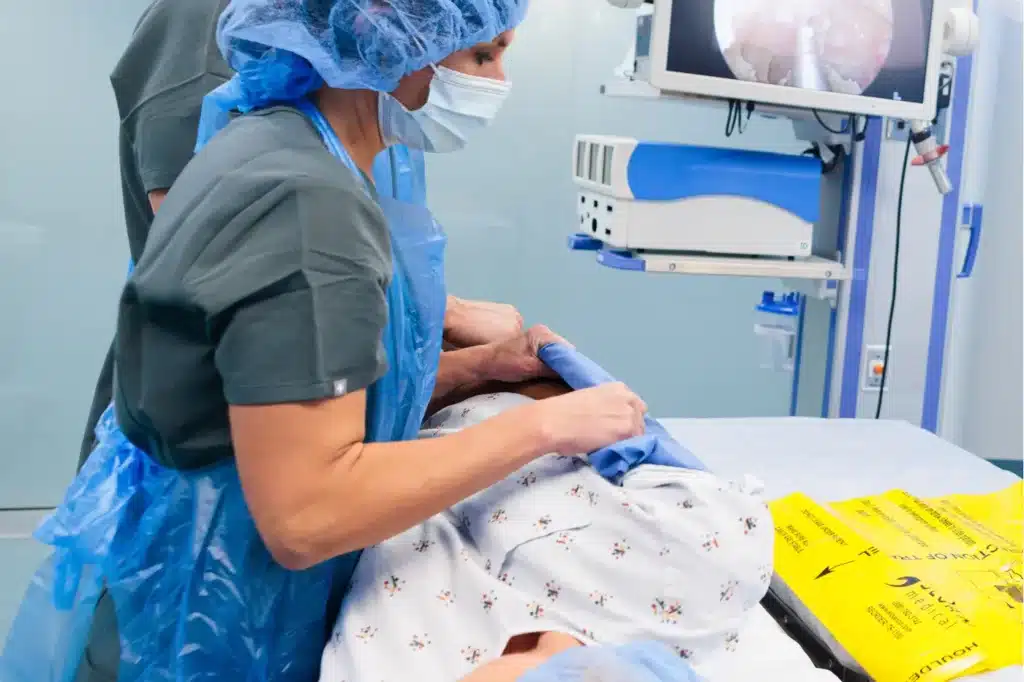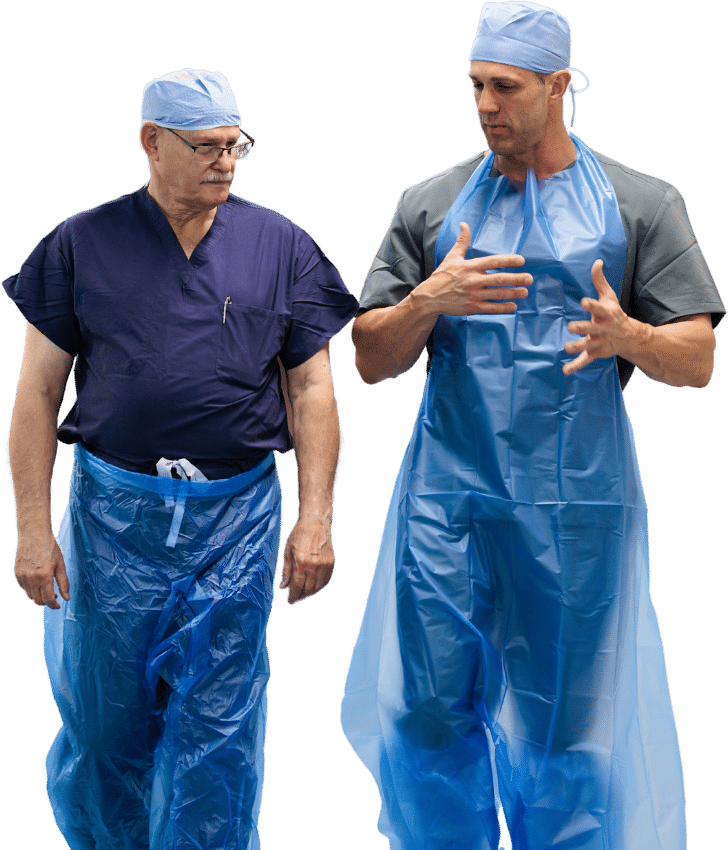They say only two things are certain in life: death and taxes. For nurses, you can add another item to the list: patient transfer problems.
There’s an epidemic of ergonomic injuries in healthcare, but pain shouldn’t be part of your job. And, of course, no one wants to see a patient get hurt.
To protect your patients, and your neck, knees, and back, you’ll want to use a variety of assistive devices to safely move patients between beds, chairs, and wheelchairs.
From transfer boards to slide sheets and patient lifts, using the right equipment at the right time is essential. Proper techniques, supplies, and training are the key.
The Importance of Safe Patient Handling Procedures
Safe patient handling is a catchall term for the proper techniques and equipment needed to lift, transfer, and move patients in a way that prevents injury to both the patient and nurses. Injuries from improper patient handling are a common occupational hazard for healthcare workers and can result in long-term physical damage.
Proper transfer reduces the risk of injuries for both patients and staff when patients need to move from one place to another, and patients feel more secure during the transfer process.
Safe patient handling helps healthcare providers reduce the risk of musculoskeletal injuries in hospitals and surgical clinics. It also ensures that patients are moved and transferred in a way that minimizes discomfort and maintains their dignity. This ultimately leads to better patient outcomes, happier staff, and a higher standard of care.
Keep reading our guide to safe patient handling programs here.
Types of Assistive Devices for Patient Transfer
Assistive devices can make the common task of patient transfer easier and safer for everyone. These tools help both patients and caregivers.
Transfer Belts
A transfer belt, also known as a gait belt, is typically made of durable fabric with a buckle or secure fastening mechanism. A nurse should use one of these belts when assisting a patient with walking or transferring from one location to another.
Here’s how to effectively use a transfer belt:
1. Preparation: Before attempting to move a patient, ensure the area is clear of obstacles and that you have enough space to perform the transfer safely.
2. Fitting the Belt: Place the transfer belt around the patient’s waist, ensuring it fits snugly but not too tightly. The belt should be positioned over clothing rather than directly on the skin to prevent discomfort.
3. Securing the Patient: Securely fasten the buckle and check that the patient feels comfortable and stable while wearing the belt.
4. Positioning: Stand beside or slightly behind the patient for better leverage and support during movement.
5. Communication: Explain to the patient what will happen during the transfer process, reassuring them and allowing them to participate by helping with their movements if they are able.
6. Lifting Technique: When ready to lift or assist in moving:
– Bend your knees (not your back) for proper lifting mechanics.
– Use your legs to provide power as you help guide or lift the patient using the transfer belt.
– Keep your body close to the patient for balance and support.
Whether shifting from a bed to a chair or assisting with walking, focus on smooth motions while maintaining control of both yourself and the patient throughout the process. Once transferred, ensure that patients are settled comfortably before removing your gait belt.
Slide Boards and Patient Transfer Boards
A patient transfer board is used in hospitals to safely and easily move patients from one surface to another, such as from a bed to a stretcher.
These devices reduce the risk of injury to both the patient and the healthcare provider by providing a smooth and stable surface for transfer. They also help ensure proper body mechanics are used during the transfer process, minimizing strain and potential harm.
When considering these boards in the context of your safe patient handling program, remember these two factors:
Sanitization: Patient transfer boards should be sanitized before and after each use to prevent the spread of serious healthcare-acquired illnesses (HAIs.)
Accessibility: Ensure that your clinic or facility stocks enough patient transfer boards for high-volume times, and make sure that transfer boards and disinfecting cleaners are in close proximity to the places you’ll need to use them.
To use a patient transfer board, start by making sure the board is clean and your bedside area is free of any obstacles. Position the transfer board next to the patient’s bed or chair, ensuring that both surfaces are at the same height.
Assist the patient to sit up straight and as close to the edge of the bed or chair as possible. Then, help the patient position one end of the transfer board under their thighs and the other end on the surface they will be transferring to.
With one hand supporting the patient’s back and the other supporting their legs, guide them across the transfer board to the new surface. Make sure to move slowly and carefully to prevent any injuries.
Disposable Patient Transfer Sheets
Many modern hospitals, clinics, and nursing staff now prefer disposable patient transfer sheets over traditional slide boards. These sheets serve the same purpose as slide boards, but they’re more flexible and less of an infection control risk.
Disposable patient transfer sheets make transferring patients easier and more comfortable for both the caregiver and the patient. There’s more “give” in the material, so the sheet follows the contours of the patient’s body. Plus, disposable patient transfer sheets fit into those tighter quarters and more awkward angles than a rigid board can.
These sheets are designed to reduce the risk of injury for both the patient and the caregiver during transfers, durable and tear-resistant, providing a safe and dependable transfer solution.
The disposable nature of the sheets promotes infection control and reduces the risk of cross-contamination. A single sheet stays with a patient throughout their hospital or clinic stay, keeping any infectious material away from other surfaces, staff, and patients.
VIDEO: See how ezGLIDE is transforming patient transfer.
Sit-to-Stand Devices
Sit-to-stand devices are assistive devices designed to aid individuals in transitioning from a sitting position to a standing position, often used to facilitate mobility and independence for patients with limited strength or mobility.
Nurses should use sit-to-stand devices to assist patients in standing up from a sitting position safely. These devices help prevent falls and injuries, reduce strain on the nurse’s body when lifting or transferring patients, and promote independence for the patient. Using sit-to-stand devices also improves efficiency in patient care and can contribute to a positive patient experience.
These devices include:
- Recliner lift chairs
- Seat assist devices
- Sit-to-stand lifts (mechanical aids)
Learning how to use sit-to-stand devices will vary by hospital, clinic, and specific devices. Healthcare professionals can attend workshops or training sessions specifically designed for using these devices.
They can also refer to instruction manuals provided by the manufacturer for step-by-step guidance.
Additionally, shadowing experienced colleagues who are proficient in using sit-to-stand devices can help your staff learn the correct techniques and best practices. When learning how to use these devices, it is important to prioritize safety and patient comfort, as proper usage can prevent injuries and enhance patient care.
Mechanical Lifts & Hoists
Hoists and lifts are mechanical devices designed to safely lift and transfer patients with limited mobility. They are essential tools for nurses in many settings, especially bariatrics and obstetrics, helping to prevent injury to both the caregiver and the patient during transfers.
To use a patient hoist, start by making sure the hoist is assembled correctly, and the sling is properly attached to it.
Position the hoist next to the patient’s bed or chair, making sure the wheels are locked in place.
Gently guide the patient into the sling, ensuring they are comfortable and secure.
Use the hoist’s controls to lift the patient up, being careful to keep the hoist steady and level.
Once the patient is in the desired position, carefully lower them back down and remove the sling.
Always follow the manufacturer’s instructions and guidelines when using a hospital patient hoist to ensure the patient’s safety and well-being.
How Safe Are Your Patient Handling Procedures?
How does your hospital’s safe patient handling program measure up? Are patients being moved and handled safely? Are healthcare workers trained properly in Safe Patient Handling techniques?
OSHA has provided guidance to help you rate your facility’s Safe Patient Handling Program. Use this brief questionnaire to examine the number and nature of patient handling injuries in your hospital, identify what you are already doing well, and identify opportunities for improvement.
Compare Patient Transfer Options
Your facility has choices regarding the assistive equipment and PPE that protect your staff and patients. It can be tough to decide which option is right for your practice!





